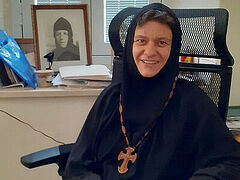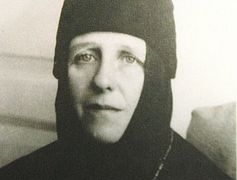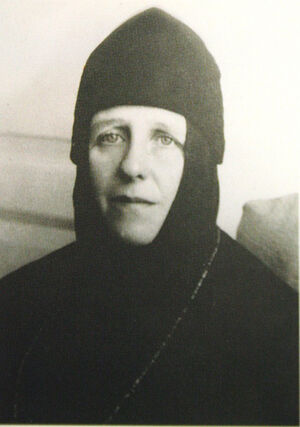 Abbess Maria (Robinson) July 8, 2021 marked the 125th anniversary of the birthday of Abbess Maria (Robinson), first abbess of the Gethsemane women’s monastic community (now a monastery) in Jerusalem. Abbess Maria, one of the eminent women of faith of the Russian Church Abroad, was the founder and first director of famous Orthodox Arabic School in Bethany near Jerusalem. For thirty-three years, she guided the renowned Gethsemane as its superior. No other Orthodox abbess in the Holy Land, neither past nor present, can outdo her singular “all-time-long” tenure at the helm of the monastery.
Abbess Maria (Robinson) July 8, 2021 marked the 125th anniversary of the birthday of Abbess Maria (Robinson), first abbess of the Gethsemane women’s monastic community (now a monastery) in Jerusalem. Abbess Maria, one of the eminent women of faith of the Russian Church Abroad, was the founder and first director of famous Orthodox Arabic School in Bethany near Jerusalem. For thirty-three years, she guided the renowned Gethsemane as its superior. No other Orthodox abbess in the Holy Land, neither past nor present, can outdo her singular “all-time-long” tenure at the helm of the monastery.
Abbess Maria was born Marion Robinson in Glasgow on July 8, 1896. Her mother, a Scotswoman, came from a family of local gentry. Her father was half-Irish, a presbyter of the Church of Scotland, and graduated from Heidelberg University in Germany. In his senior years, he authored a book entitled, Jesus Christ Reinvented, in which he voiced his opinion on Christ’s Resurrection, according to which the Savior was merely a spiritually powerful man. The publication of his book led to his excommunication from the Church of Scotland, and before very long, he all of a sudden became ill with tuberculosis and died.
She ruled the renowned Gethsemane monastery for thirty-three years as its abbess
At the time, eleven-year-old Marion was staying with family friends, when on December 4, during sleep, she heard someone telling that her father is dying. She awoke with a start and couldn’t go back to sleep, and in the morning her family arrived to take her home because her father had died earlier that night. Since then, it is fair to say that Abbess Maria was blessed with a special gift of mysticism and it was certainly why she stood out among the people around her. When Marion was seventeen, she fell ill with tuberculosis and ended up in a sanatorium, where she had a vision of the Burning Bush. She has two younger brothers who died in early childhood. Her beloved mother also died early in life. Marion and her sisters were the only ones left, and so she determined that her family members’ the early deaths were guiding her to serve Christ and people.
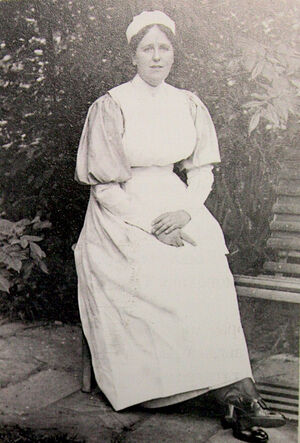 Marion Robinson wearing the uniform of the Sister of Mercy. 1920s Marion was educated in Scotland at the college of St. Leonard for women and graduated it in 1914. Afterwards, she entered a full two-year training program for the sisters of mercy at the children’s hospital in Liverpool, studying “Childhood diseases and care for sick children.” She completed her studies in 1919 and received her diploma with high honors. Thereafter, she completed a full five-year course of medical education at the London Hospital, having completed it in 1923 with a diploma and certificate of merit. On top of all that, she studied at the Social Sciences Faculty at Belford University in London, received her diploma in 1926. For the next four years, she worked as a government employee. She was confirmed at the High Church of England at St. Paul’s Cathedral by the Archbishop of London and became a novice in the Christ the Healer monastic community. She was later chosen to go to Puna, India with a group of clergymen and women missionaries, where, in the Diocese of Archbishop of Bombay and with his blessing, she founded a missionary center—a house for outpatients—with the purpose of offering spiritual and physical care for the suffering. On August 10, 1929, Marion was tonsured a nun according to the rites of the High Church of England, taking life vows. She was given the name Stella.
Marion Robinson wearing the uniform of the Sister of Mercy. 1920s Marion was educated in Scotland at the college of St. Leonard for women and graduated it in 1914. Afterwards, she entered a full two-year training program for the sisters of mercy at the children’s hospital in Liverpool, studying “Childhood diseases and care for sick children.” She completed her studies in 1919 and received her diploma with high honors. Thereafter, she completed a full five-year course of medical education at the London Hospital, having completed it in 1923 with a diploma and certificate of merit. On top of all that, she studied at the Social Sciences Faculty at Belford University in London, received her diploma in 1926. For the next four years, she worked as a government employee. She was confirmed at the High Church of England at St. Paul’s Cathedral by the Archbishop of London and became a novice in the Christ the Healer monastic community. She was later chosen to go to Puna, India with a group of clergymen and women missionaries, where, in the Diocese of Archbishop of Bombay and with his blessing, she founded a missionary center—a house for outpatients—with the purpose of offering spiritual and physical care for the suffering. On August 10, 1929, Marion was tonsured a nun according to the rites of the High Church of England, taking life vows. She was given the name Stella.
At the beginning of 1932, Stella (Robinson) and Catherine (Sprot), two Anglican nuns and Scotswomen by birth, settled in one of the rental properties in Russian Gethsemane as pilgrims to the Holy Land on their way back home from their missionary trip to India. Seeing the disastrous state of Russian Gethsemane and its plot of land in Bethany, they felt the desire to stay and offer their help. That’s how the selfless work of heterodox nuns at the Russian Ecclesiastical Mission in Palestine began.
Both of them, as Scotswomen from high-profile families, were able to gather support from the British ruling authorities in Palestine that was largely extended to the Mission as well. The authorities began to cooperate with the Russians to the extent it was possible. In her communication with the British administration, Stella (Robinson) placed particular emphasis on the fact that the Church in Gethsemane was the final resting place of Grand Duchess Elizaveta Feodorovna, the sister of the last Russian Tsar and the granddaughter of the British monarch Queen Victoria. The mutual work to build the Orthodox community brought the Anglican nuns closer to their Orthodox counterparts. They began to attend the services in the Church to St. Mary Magdalene, while Sister Valentina (Tsvetkova) helped them learn the Russian and Church Slavonic languages.
In September of 1933, both sisters were received into the Orthodox Church with their original names of Maria (Marion) and Alexandra (Alix) returned to them in baptism.
With the blessing of Vladyka Anastasy, a monastic residence was founded in Bethany with Sister Maria appointed its nun superior. Maria was tonsured a nun under the same name at the Church of St. Mary Magdalene in August 1934. Three months later, Vladyka Anastasy tonsured Sisters Alexandra (Sprot) and Valentina (Tsvetkova), giving them the names of Martha and Barbara. As envisioned by Vladyka Anastasy, the community in Gethsemane was to serve God in prayer and ascetic deeds in the manner of Maria from the Gospels, while Bethany was to serve others, like Martha. Nun Maria was appointed senior nun of the Russian Gethsemane plot in Jerusalem and the keeper of the burial vault of Grand Duchess Elizaveta Feodorovna and Nun Barbara. Nun Barbara was assigned to assist her in Gethsemane, while nun Martha was assigned to serve in Bethany. That’s how a tiny monastic community was formed.
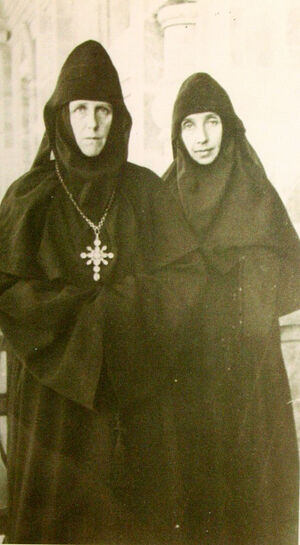 Hegumenia Maria with her first assistant sister Valentina (Tsvetkova), the future Abbess Barbara of Gethsemane from 1969–1983 In the fall of 1936, Nun Maria was elevated to the rank of abbess and given a pectoral cross with decorations. The life of the new monastic community during the Second World War, which began in 1939, was full of hardships. But thanks to Abbess Maria, who had transferred her entire inheritance to the needs of the monastery, as well as the support from Nun Martha’s family, they never ran short of money. All this time, Abbess Maria sought the possibility to get in touch with Metropolitan Anastasy, who had departed for Europe in 1935, and headed the Synod of the Russian Church Abroad from 1936. However, the first news from Vladyka would arrive only in 1994 with the help of the Red Cross. Nevertheless, under the direction of Archimandrite Seraphim (Sedov), the Gethsemane community held regular church services according to the typicon for Russian monasteries.
Hegumenia Maria with her first assistant sister Valentina (Tsvetkova), the future Abbess Barbara of Gethsemane from 1969–1983 In the fall of 1936, Nun Maria was elevated to the rank of abbess and given a pectoral cross with decorations. The life of the new monastic community during the Second World War, which began in 1939, was full of hardships. But thanks to Abbess Maria, who had transferred her entire inheritance to the needs of the monastery, as well as the support from Nun Martha’s family, they never ran short of money. All this time, Abbess Maria sought the possibility to get in touch with Metropolitan Anastasy, who had departed for Europe in 1935, and headed the Synod of the Russian Church Abroad from 1936. However, the first news from Vladyka would arrive only in 1994 with the help of the Red Cross. Nevertheless, under the direction of Archimandrite Seraphim (Sedov), the Gethsemane community held regular church services according to the typicon for Russian monasteries.
In 1948, the British mandate over Palestine had ended, and the Arab-Israel war ensued in May of the same year, changing the existing order in the region. The whole region was embroiled in battles. Nuns Maria and Martha, as British passport holders, were repeatedly urged to return to their home country but they flatly refused to leave. Under no circumstances could they leave the sisters and the holy relics of Grand Duchess Elizabeth and Nun Barbara. Tremendous credit for the preservation of great martyrs’ relics for future generations goes to Abbess Maria and others. The gates of Bethany and Gethsemane remained open to welcome a great many Russian and Arab refugees, who were even settled in the caves of Russian Gethsemane. The church services were never interrupted there.
The war brought the division of Jerusalem and Palestine between the newly formed state of Israel and Jordan. By then, Stalin had expressed strategic interest in the Middle Eastern states and the Soviet administration asserted its right to the church property of Tsarist Russia in Palestine. The government of the state of Israel, which happened to own most of the land once acquired by Archimandrite Antonin (Kapustin) for the Russian Ecclesiastical Mission, by then maintained by weary Russians, encountered the USSR’s desire to claim it. Sustained efforts were made to talk the government of Transjordan into transferring the Russian property to Moscow. Pressure was also exerted through the Patriarch of Jerusalem, who attempted to influence Archimandrite Antony (Senkevich), an outspoken monarchist and the director of the Russian Ecclesiastical Mission at the time. Despite the inflexibility of the Jordanian royal family regarding this matter, the situation around the Russian monasteries on the Mount of Olives and in Bethany remained complicated.
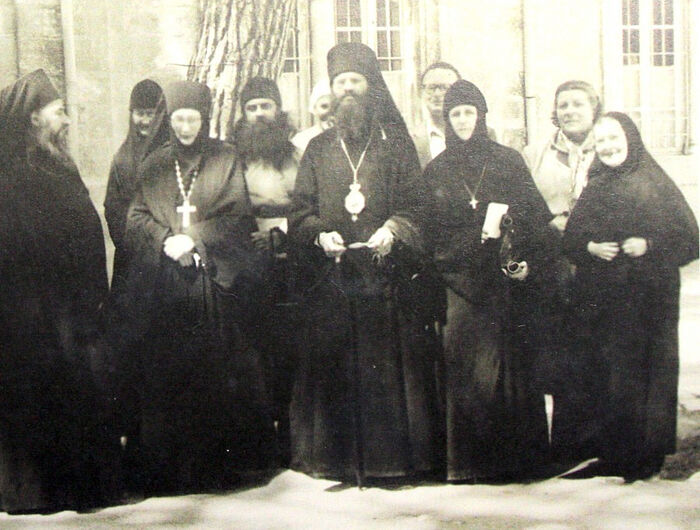 At the Mount of Olives, 1954, from left to right: Archimandrite Dimitry (Biakay), Nun Sophia (Krylatova), Abbess Tamara, Archimandrite Antony (Bartoshevich), future Archbishop of Geneva, Bishop Leonty (Bartoshevich) of Geneva. Konstantin Studentsov, an artist from Brussels, Abbess Maria (Robinson) of Gethsemane
At the Mount of Olives, 1954, from left to right: Archimandrite Dimitry (Biakay), Nun Sophia (Krylatova), Abbess Tamara, Archimandrite Antony (Bartoshevich), future Archbishop of Geneva, Bishop Leonty (Bartoshevich) of Geneva. Konstantin Studentsov, an artist from Brussels, Abbess Maria (Robinson) of Gethsemane
Abbess Maria worried for the future of the community and the tombs with the remains of the new martyrs Elizabeth and Barbara entrusted to her care. Accompanied by Nun Barbara, she traveled to London and later to Munich to meet with Metropolitan Anastasy and discuss their present situation. They were able to reestablish communication with their superiors at the Russian Church Abroad, and soon afterwards, Archimandrite Dmitry (Biakay) arrived to serve as the father confessor of the Bethany community and later as the head of the Mission. He came in the company of novices, a group of sisters from Europe. It was the Gethsemane monastic community headed by Abbess Maria that brought forth Abbess Tamara, the renowned abbess of the Russian Mount of Olives (formerly Princess Tatiana Konstantinovna Romanova-Bagration-Mukhranskaya).
From the moment this community was founded, the “lower house” situated on the parcel of Russian Gethsemane was no longer rented out; it began to be used as the Abbess’s quarters, a monastic residence, and an office. Slightly further up the hill, another building with four spacious rooms was added as a residence for sisters (currently used as a hotel). The sisters also resided in the church basement.
After 1948, the financial situation of the convents in Jerusalem remaining under the omophorion of the Russian Church Abroad became further complicated when they lost part of the income received from renting out the Russian properties that ended up on the Israeli side. The community had largely depended on the support received from the Synod of the Russian Orthodox Church Abroad, personal donations by pilgrims, as well as what the sisters could earn by painting icons, embroidery and weaving, translations and lessons. But, as before, they primarily depended on Abbess Maria and Nun Martha’s finances.
The Gethsemane and Bethany community continued its noble and God-pleasing work of Martha and Mary from the New Testament, as well as that of Grand Duchess Elizabeth Feodorovna. The young and educated Russian and Arab sisters worked together at the monastery school for Arab girls, as well as in the field of missionary work, preserving Orthodoxy in the Holy Land by publishing monthly missionary leaflets in Arabic and, with the blessing of Patriarch Timothy of Jerusalem, distributing them among the local parishes and the Orthodox churches elsewhere in the Middle East. Besides that, they carried on extensive correspondence with people from around the world, took trips conducting religious and educational outreach work at the remote Orthodox settlements in Palestine, and established contacts with the local parishes. During Holy Week and Pascha, Bethany opened its doors to pilgrims from Greece, staying connected and corresponding with them long after their departure.
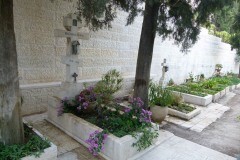 The grave of Matushka Maria (Robinson) in the Gethsemane In the early 1950s, with the blessing of Metropolitan Elijah, another convent was founded in Lebanon. Its future nuns resided at the Bethany community for over a year preparing for their life as monastics. The school in Bethany gave the Orthodox world many devout Arab nuns who went on to serve all over the world in places like Chile, Argentina, France, England, and Greece. In Chile, they founded a monastic community modeled after Bethany, and the children’s orphanage named after St. John of Kronstadt, as well as the Annunciation convent in London. Surely, a lot of them joined the women’s monasteries on the Mount of Olives. The Bethany Orthodox School overseen by the Gethsemane convent is one of the famous and prestigious establishments throughout the Middle East. The author thinks it appropriate to name the Bethany School after Abbes Maria.
The grave of Matushka Maria (Robinson) in the Gethsemane In the early 1950s, with the blessing of Metropolitan Elijah, another convent was founded in Lebanon. Its future nuns resided at the Bethany community for over a year preparing for their life as monastics. The school in Bethany gave the Orthodox world many devout Arab nuns who went on to serve all over the world in places like Chile, Argentina, France, England, and Greece. In Chile, they founded a monastic community modeled after Bethany, and the children’s orphanage named after St. John of Kronstadt, as well as the Annunciation convent in London. Surely, a lot of them joined the women’s monasteries on the Mount of Olives. The Bethany Orthodox School overseen by the Gethsemane convent is one of the famous and prestigious establishments throughout the Middle East. The author thinks it appropriate to name the Bethany School after Abbes Maria.
Abbess Maria peacefully fell asleep in the Lord on November 6, 1969, at the age of seventy-two, and was solemnly buried on the grounds of St. Mary Magdalene Convent in the Garden of Gethsemane of the Russian Orthodox Church Abroad that she guided for thirty-three years. Her grave is one of the venerated relics of the Gethsemane convent.
The name of Abbess Maria (Robinson) was forever etched in golden letters in the annals of the history of the Russian Orthodox Church Abroad. A foreigner by birth and a pious monastic, Abbess Maria enriched Russian Orthodoxy with her glorious deeds of building, mercy and compassion. May her memory be eternal!


